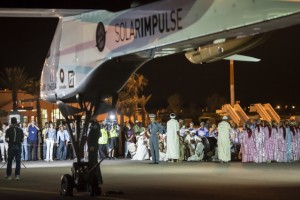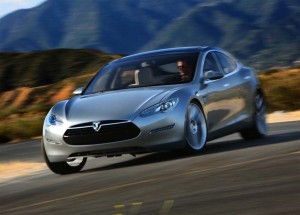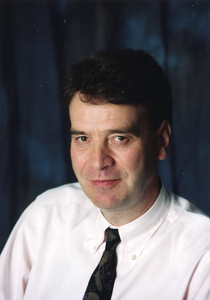 After completing its historic 2,500-kilometer intercontinental flight to Morocco earlier this month, the Swiss solar-powered plane, Solar Impulse, lifted off from Morocco’s capital Rabat this morning on the second attempt at its most challenging flight yet — to the Sahara desert and Ouarzazate, where Morocco is building the world’s largest solar-thermal plant to harness renewable power from the Sahara sun for North Africa and Europe. The pioneering solar-powered aircraft faced “difficult meteorological conditions” that last week forced pilot Andre Borschberg to turn back after experiencing unexpectedly strong headwinds halfway through the flight. Today, Solar Impulse took off from Rabat at 7:05 A.M. local time and flew over the Atlas Mountains before heading for a landing at Ouarzazate expected around midnight local time (early evening Thursday Eastern Time).
After completing its historic 2,500-kilometer intercontinental flight to Morocco earlier this month, the Swiss solar-powered plane, Solar Impulse, lifted off from Morocco’s capital Rabat this morning on the second attempt at its most challenging flight yet — to the Sahara desert and Ouarzazate, where Morocco is building the world’s largest solar-thermal plant to harness renewable power from the Sahara sun for North Africa and Europe. The pioneering solar-powered aircraft faced “difficult meteorological conditions” that last week forced pilot Andre Borschberg to turn back after experiencing unexpectedly strong headwinds halfway through the flight. Today, Solar Impulse took off from Rabat at 7:05 A.M. local time and flew over the Atlas Mountains before heading for a landing at Ouarzazate expected around midnight local time (early evening Thursday Eastern Time).
Pilot Andre Borschberg was forced to fly the Solar Impulse back to Rabat when turbulence made it impossible to cross the Atlas Mountains in southern Morocco on June 14, 2012. But yesterday’s second attempt was finally successful, and the team was welcomed in Ouarzazate by a jubilant crowd. The 683 km journey was completed in 17 hours and 20 minutes at an average altitude of 16, 405 feet. Reports Green Profit. The solar plane, powered by 12,000 solar cells in its 207-ft wing-span and not a drop of fossil fuel, touched down in Morocco on June 5 after flying from Switzerland via Madrid. After landing, the Solar Impulse team joined events highlighting renewable energy technologies, under the patronage of King Mohammed VI and at the invitation of the Moroccan Agency for Solar Energy, MASEN, which oversees Morocco’s solar energy plans.
MASEN President Mustapha Bakkoury welcomed Solar Impulse pilot Bertrand Piccard at Rabat’s airport, calling the flight important for raising awareness about solar energy’s potential to reduce global dependence on oil, and saying, “we share a common message with Solar Impulse.” He said Morocco will be producing solar energy by 2014, when Solar Impulse plans to fly a round-the-world tour. The solar flight to Morocco coincides with construction launch of a World Bank-financed solar thermal project in Ouarzazate — the first of five sites — that will produce 2,000 megawatts of renewable energy from the Sahara sun and create many jobs in the area. When it reaches Ouarzazate, Solar Impulse plans to fly over the site and land nearby to show its support for the innovative solar power project.
Hotels house honeybees on rooftops


 Sustainable Development
Sustainable Development




